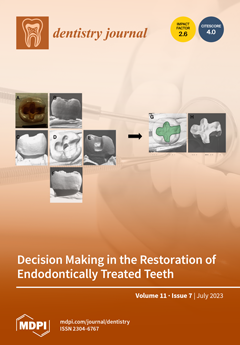This retrospective study addressed the role of oral potentially malignant disorders and the presence of intraepithelial
Candida hyphae in the carcinogenesis of the oral tongue squamous cell carcinoma and its association with smoking, alcohol consumption, and oral inflammatory burden. The medical records of
[...] Read more.
This retrospective study addressed the role of oral potentially malignant disorders and the presence of intraepithelial
Candida hyphae in the carcinogenesis of the oral tongue squamous cell carcinoma and its association with smoking, alcohol consumption, and oral inflammatory burden. The medical records of 183 subjects diagnosed with oral tongue squamous cell carcinoma at the Helsinki University Hospital were investigated. Preceding oral lichen planus, lichenoid reaction, and leukoplakia diagnosis were recorded. Further, the data on
Candida hyphae in histological samples as an indicator of oral candidiasis, oral inflammatory burden, smoking, and alcohol consumption were recorded and analyzed. The histopathological diagnosis of oral lichen planus/lichenoid reaction (
p < 0.001) and the presence of
Candida hyphae (
p = 0.005) were associated significantly with female gender. Oral lichen planus/lichenoid reaction patients were less often smokers than patients without these lesions.
Candida hyphae were more often recorded in patients without alcohol use (
p = 0.012). Oral lichen planus/lichenoid reaction and
Candida hyphae in histological samples were associated with female gender and lower levels of typical risk factors, such as alcohol use and smoking, in oral tongue squamous cell carcinoma patients. Therefore, these patients should be well monitored despite a potential lack of the classical risk factors of oral carcinoma.
Full article






